Have you heard of winter sowing?
Odds are that if you spend any time in gardening circles, you have. But what is it? And why does this seem to be all the rage in seed starting all of a sudden?
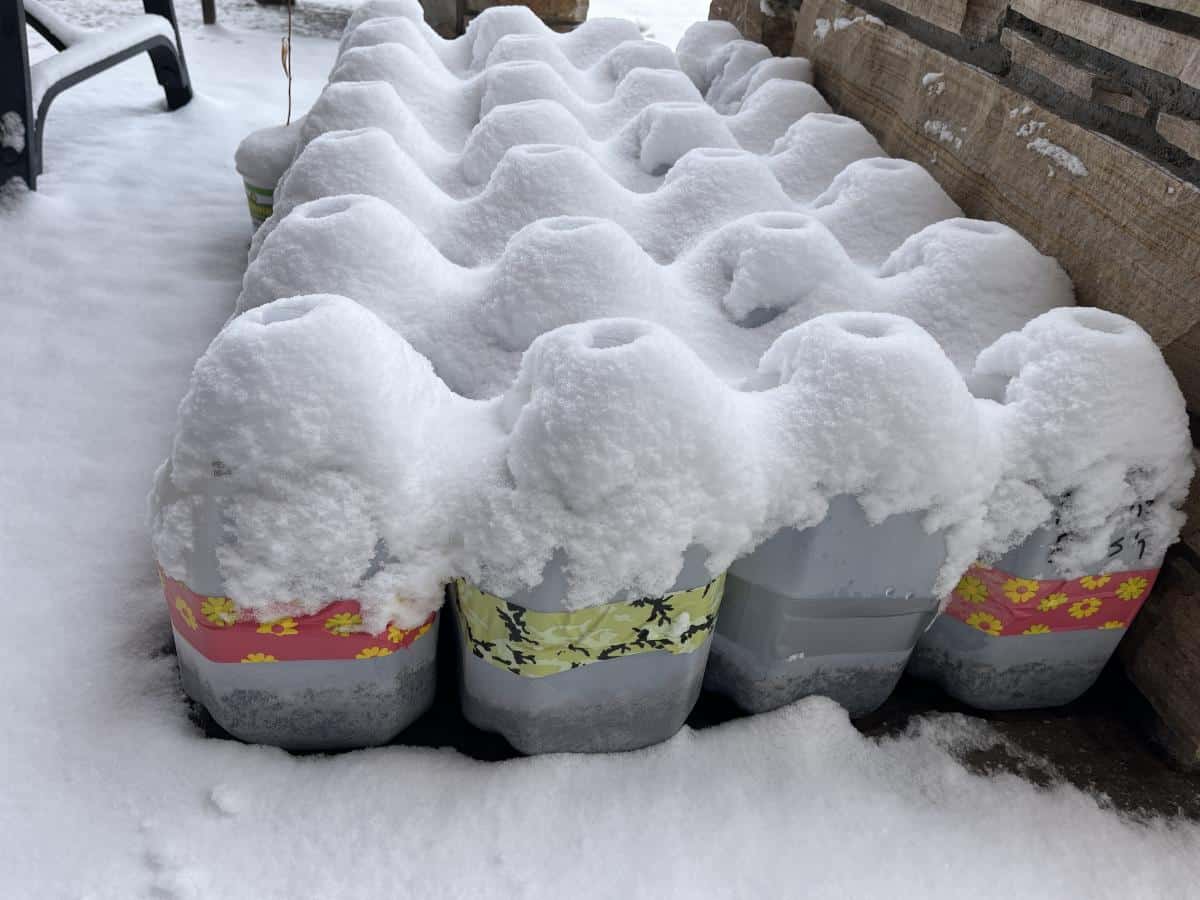
Even the seed companies and universities seem to be pretty on board with this “new” method of starting your garden plants from seed. Let’s take a look at what it is and if winter sowing is right for you.
Jump to:
- What is Winter Sowing?
- The Basics of How to Start Seeds with the Winter Sowing Method
- Timing Winter Sowing
- Sow seeds after temperatures drop low enough
- Some tips for timing winter seed sowing:
- Which Seeds Are Best for Winter Sowing?
- What to look for in seed descriptions when choosing winter sowing seeds
- Some Pros and Cons of Winter Sowing to Consider
- Is Winter Sowing Right for You? Is Starting Seeds Indoors a Better Idea?
What is Winter Sowing?
Let’s be clear. Winter sowing is not planting seeds in the ground in winter. It is an alternative method of starting transplants from seed. In containers. (Usually milk jugs).
Winter sowing takes the place of starting seeds indoors, such as under grow lights or in a greenhouse. Depending on your goals and timing, you may choose to replace some or all of your indoor seed starting with winter sowing (more tips on this in the section below).
The process of winter sowing mimics the way that seeds fall naturally to the ground, get covered by falling leaves, or the process of being driven into the soil by heavy rains and freezing and expansion, and then naturally germinate in the spring when temperatures warm.
Seeds are kept naturally moist—similar to life in the ground—by snow and rain. They are also kept in covered, low-evaporation mini greenhouses of sorts, which helps them maintain moisture. Seeds and seedlings are well protected from the weather extremes that are common in winter and early spring.
Since you are growing transplants, you’ll also have an easier time weeding and maintaining the plants once they are in the garden, and you won’t risk forgetting where you planted those seeds way back in the fall.
The winter sowing process provides the cold stratification that many seeds require before they can break dormancy and sprout. This is common for perennial seeds and many types of flowers and wildflowers. Cold treatment is also quite common for herbs (lavender comes to mind!).
If you’ve struggled with germination for any of these in the past, cold stratification may be to blame, and winter sowing may be a good answer.
The Basics of How to Start Seeds with the Winter Sowing Method
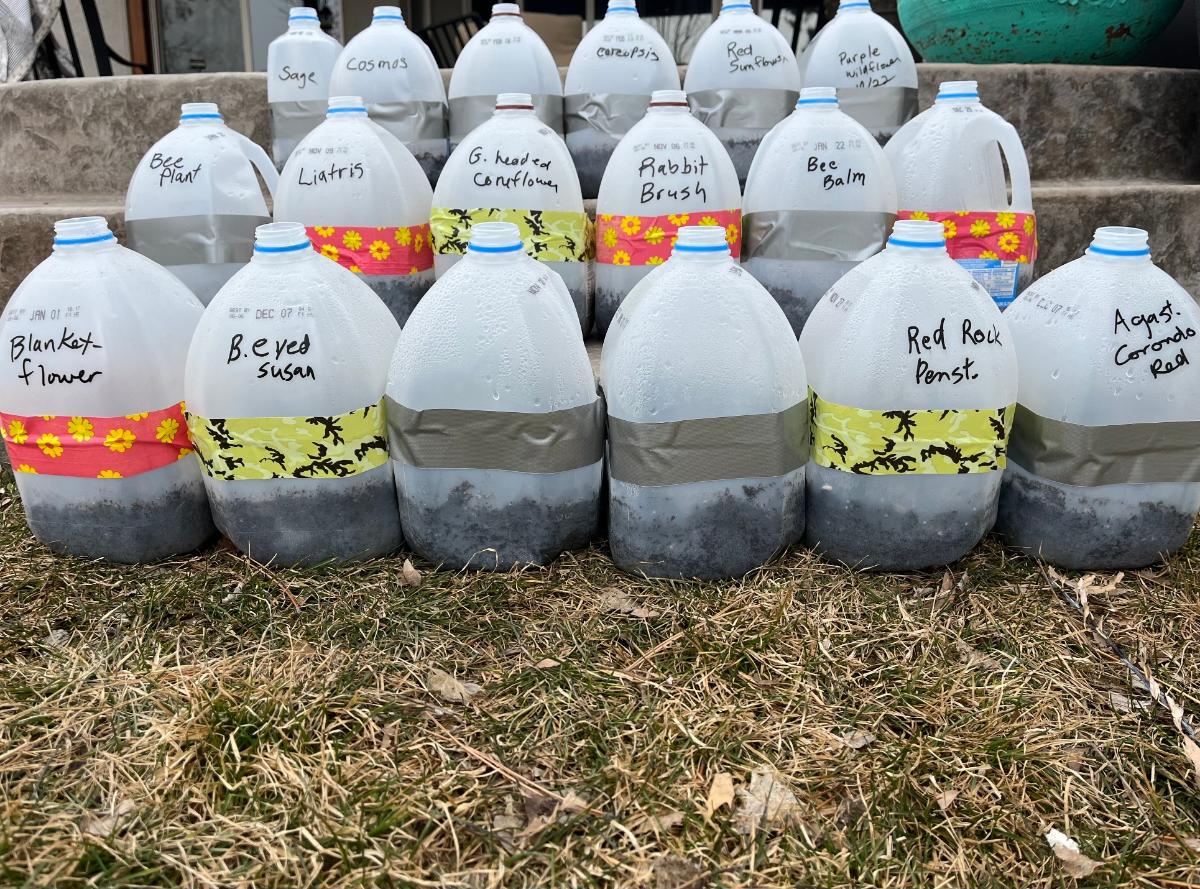
The way that most people winter sow is to collect large milk or water jugs (one-gallon size) and turn them into mini greenhouses. The jugs are cut in half, drainage holes are poked in the bottom, and then the containers are filled with a few inches of soil. Then, the seeds are planted according to the package’s directions.
Once planted, the top is taped back onto the jug with heavy tape. The jugs are then set outside in a space that gets both light and weather.
- Access to snow and rain is important so the jugs can get moisture naturally
- Caps are left off the jugs to allow small amounts of precipitation in to water the seeds while also limiting evaporation
- The jugs should not be set out in the shade because the seedlings will need sunlight eventually, too. This is all part of working with nature to grow your plants!
- The changes in the seasons—warmer days, longer daylight, and stronger sunlight will naturally trigger your seeds to sprout
- Each type of seed should sprout according to its natural response to temperature, so seeds will sprout at different times throughout the spring
- This is why you can start all the seeds at once and have them develop naturally—just like they would if they’re dropped on the ground and if they self-sowed
- You will need to protect seedlings from frost if they are tender annuals or sensitive to frost and freezing
Learn how to make an upcycled milk jug winter sowing container here.
Timing Winter Sowing
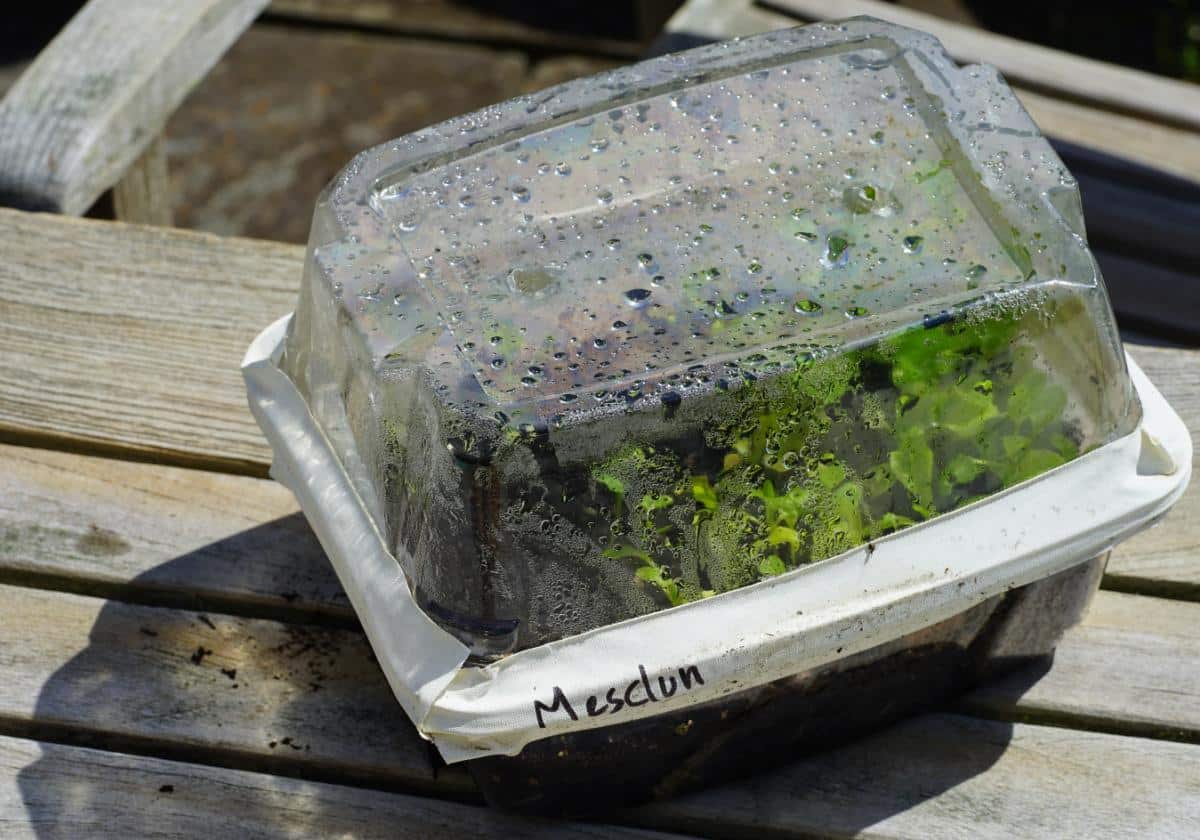
Though you can stagger and time the seeds if that is what works best for you, you don’t have to—for the reasons listed above.
Seeds will start when the germination temperatures are right for them, cued by nature and seasonal changes.
But not all of the things we grow in our gardens are native to our location. This is typically the situation for many vegetables and annual plants (like tomatoes, peppers, eggplant, and more).
That means that they may sprout before they are strong enough to survive the frosts of late spring, which means that after tender plants have sprouted and started growing, they need to be covered when frost comes or moved indoors at night and in freezing weather.
This is not an issue before the seeds germinate. Intact seeds will survive freezing. It is only an issue after the seeds sprout and begin to grow.
Timing is more important for seeds that need cold stratifying because you need to make sure they experience enough cold days and nights. This is a simple matter to overcome—just plant early with plenty of cold days ahead of you.
For the most part, cold stratifying seeds can’t have too many cold days, but they cannot have enough.
Sow seeds after temperatures drop low enough

It is possible to sow seeds too early if you are sowing before the winter cold really sets in. Because winter weather seems to be coming later for many of us, you may have to wait longer than you once would.
If your late fall and early winter days are still moderate, hold off on winter sowing. Ideally, you’ll be experiencing consistent cold weather before you start your winter sowing.
The problem with starting when days are still in the 40-to-50-degree Fahrenheit range (4.4 C to 10 C) is that those conditions mimic early spring, which is a time when seeds might start waking up. Seeds can prematurely germinate, and the young seedlings may die when the real deep cold of winter hits.
Remember that a lot of perennials and plants that can take frost still cannot take a hard freeze—weather that may still be ahead of you. This is less of a concern for seeds that don’t sprout without cold stratifying because they will not sprout until after they experience that prolonged period of cold.
It is a definite issue for most of the annuals and vegetables you’d plant for your garden, though, because most of those sprout just from moisture and warmth and don’t depend on cold stratification.
Some tips for timing winter seed sowing:
- 30 to 60 days (about 2 months) is the average period of time for seeds that need to experience cold (in other words, those that need cold stratification usually need to experience freezing or near freezing temperatures for one to two months in order to break dormancy and develop)
- December through March is the most common time range for winter sowing
- December and January are recommended for seeds that need cold stratifying
- Hold off until January if your winters come later (i.e. if December stays warm with mostly thawed, muddy conditions)
- Later sowing, such as March and April are for annuals and seeds that don’t need cold stratifying; don’t try to start cold-stratified seeds this late
- Annuals that do not need cold stratifying can still be sown early (in January, for example) when you are sowing your cold-stratified seeds if you want to get it all done at once
Which Seeds Are Best for Winter Sowing?

The best candidates for winter sowing are perennial seeds and seeds that need cold treatment. Wildflowers and other seeds that tend to self-sow often make good candidates, because they are designed to sprout in tandem with nature, and they are designed by nature to survive winter weather.
Though technically, any seeds can be winter sown, herbs, perennials, and cold-hardier vegetables and annuals (usually those that survive some fall frosts) are best suited to it. These are often the seeds that germinate earlier and at lower temperatures.
Seeds with hard coats that should be scarified (nicked or cut to break the seed coat) do well with winter sowing, too.
Some examples of good candidates for winter sowing include:
- Asparagus
- Strawberries
- Cole crops (broccoli, cauliflower, cabbage, etc.)
- Lettuce
- Spinach
- Greens
- Alliums (onions, shallots, leeks)
- Lavender
- Lemon balm
- Chives
- Sage
- Thyme
- Oregano
- Parsley
- Mint
- ...most any herb
- Dianthus
- Echinacea (coneflower)
- Black Eyed Susans (Rudbeckia)
- Yarrow
- Columbine
- Marigolds
- Snapdragons
- Sweet peas
- Morning glory
- Nasturtium
- Pansies
- Violas
What to look for in seed descriptions when choosing winter sowing seeds
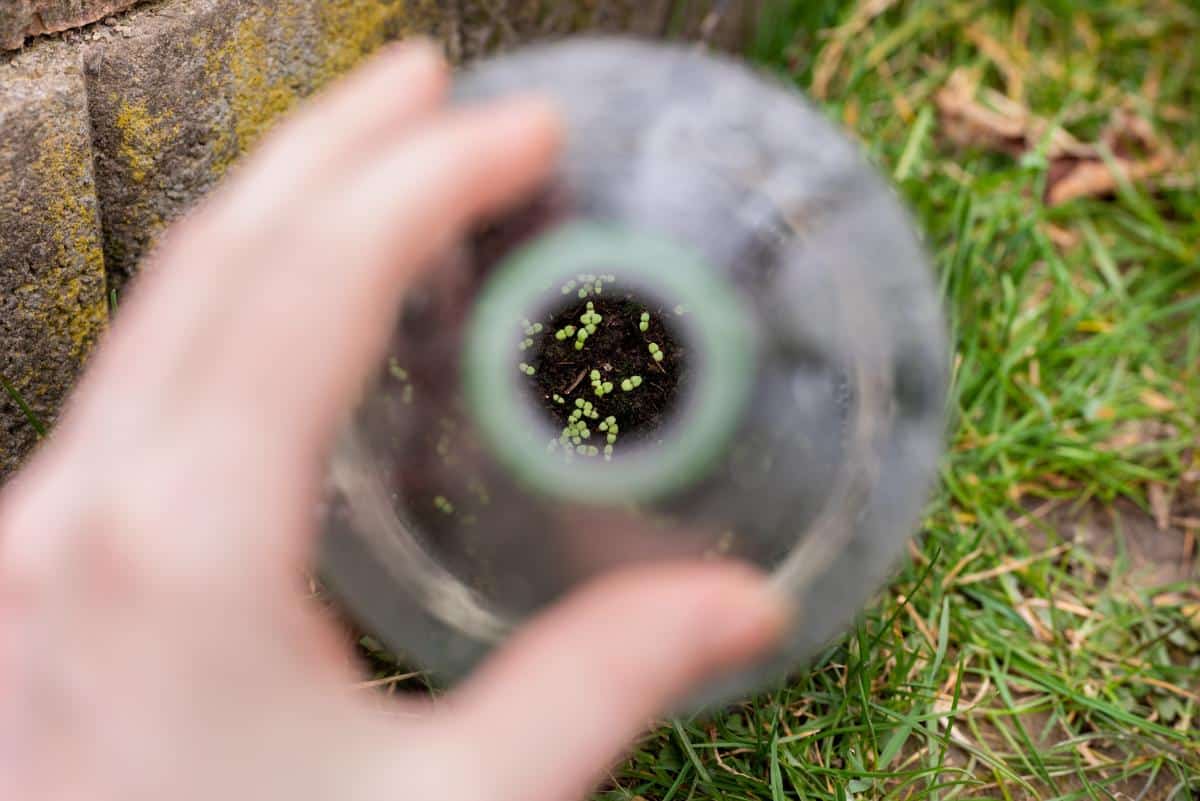
Seed instructions and descriptions can give you hints as to whether a seed will do well with winter sowing. You can usually find this information on a seed packet or in seed catalogs, or in online descriptions.
To find seeds that are well suited to winter sowing, look at the germination requirements. These are some keywords to look for:
- Self-seeding or reseeds
- Self-sows
- Colonizes
- Hardy seed
- Cold hardy
- Withstands frost
- Sow outside in the fall
- Sow outside in early winter
- Sow outside in early spring (before the last frost date or when frost may still occur)
- Seed must be pre-chilled
- Needs to be cold stratified/requires cold stratification
Plants that have these characteristics or requirements are plants that know to stay dormant until the right conditions are present, or they are plants/seeds that don’t sprout until after long exposure to moist, cold temperatures. Basically, these things tell you the seeds follow the signs of nature and/or will do well, having to endure some cold.
Some Pros and Cons of Winter Sowing to Consider
- A simple, efficient way to start seeds
- Works in rhythm with nature and the natural warming and turning of the seasons
- Seeds germinate and start later compared to seeds started indoors
- Less control over timing compared to seeds started indoors under grow lights
- If the year warms early, seeds may germinate early but can have problems if the weather turns back cold and severe (more of an issue for annuals and more tender plants)
- A delayed or cold spring can delay germination, which may leave you with young or weak seedlings at planting time (assuming the weather catches up for a normal planting time in late spring/summer)
- No grow lights needed, and no increased utility/electricity expense
- Does not take up space indoors
- Tender annuals and frost-sensitive plants will still need protection from frosts and freezes that occur after the seeds germinate
- Starting seeds indoors will give you the earliest start and the biggest transplants
- If you want larger transplants or plants ready to plant or bloom as soon as frost stops, starting indoors may be the better choice
- Winter sowing is an excellent choice for seeds that need to be cold-stratified (this is often the case for a lot of herbs and wildflowers)
- Winter sowing takes less hands-on time managing seedlings to transplant size
- There are fewer steps involved in winter sowing and less potting up
- Less time is spent watering and maintaining plants in the winter months
- Seeds are protected from rodents and birds
- Seeds and seedlings have better protection from weather and erosion than seeds in the ground over winter
- Plants usually go from the growing container straight into the ground
- Plants should be better acclimated to outdoor living and not need hardening off as indoor-grown seedlings would
Is Winter Sowing Right for You? Is Starting Seeds Indoors a Better Idea?
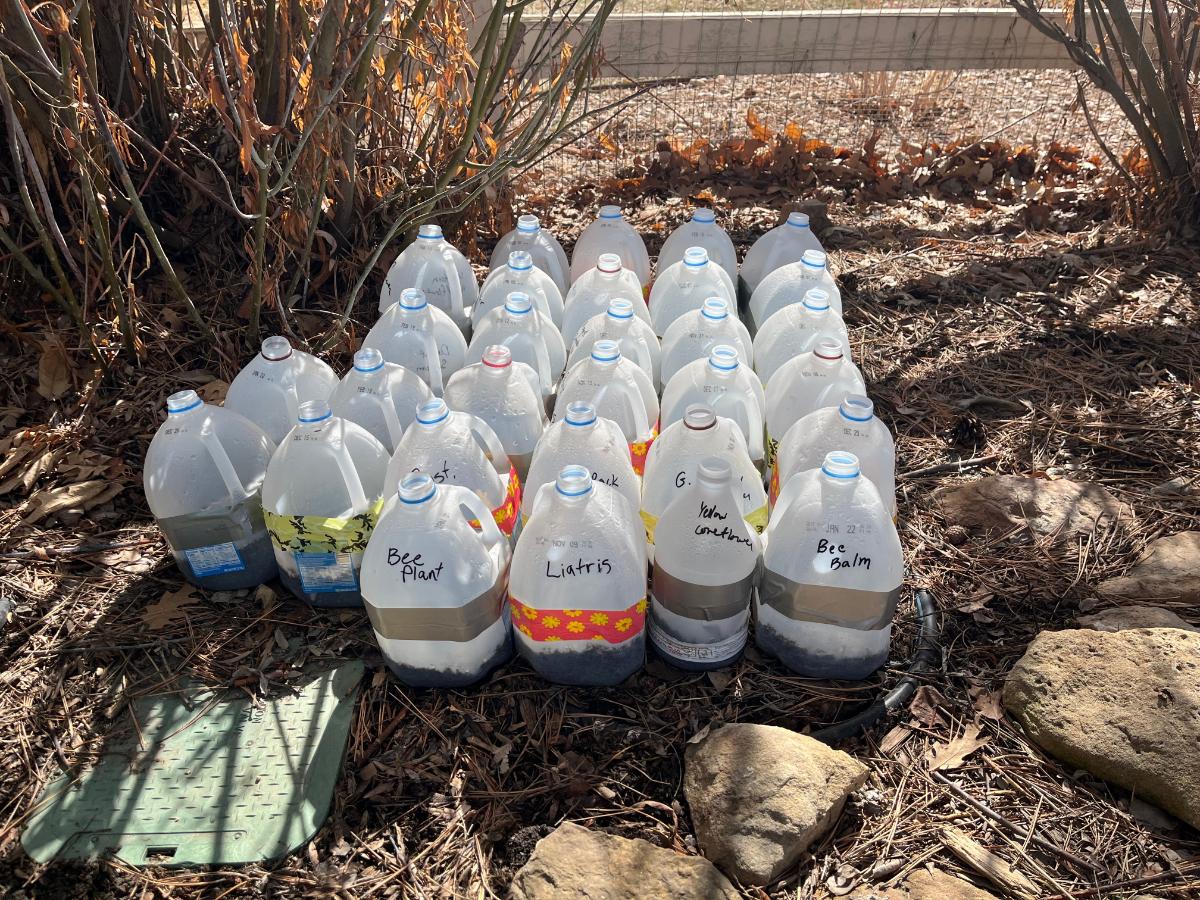
Preferences and results with winter sowing are mixed; some people start all their seeds via the winter sowing method. A lot of people choose to start only seeds that need to be cold-stratified or that are cold and frost-hardy and do better with cooler temperatures.
There’s no right or wrong answer to this. Some of the pros and cons above might guide your decision. For example, do you struggle to get seeds to germinate that need cold stratifying? Would you rather let that process happen naturally instead of having to stash prepped seeds in your fridge for weeks or months (and remember them there?)
Do you like the “set it and forget it” style of gardening winter sowing offers you? Does the efficiency and hands-off approach interest you?
Maybe space and lighting for indoor seed starting are difficult for you to manage.
On the other hand, maybe you want bigger transplants or blooming flowers earlier, in which case starting inside is the right answer.
If you’re not sure, maybe try starting certain things, like cold stratifying seeds, perennials, and herbs with winter sowing, but still start tender things that you’d worry about in freak frosts inside.
Winter sowing is a good method that is gaining a lot of traction. There are whole Facebook groups devoted to it, with many devotees. This is a method worth trying. And who knows? You might just find that it becomes the one and only seed-starting method for you!
Or, you might add it to your repertoire of gardening techniques. Either way, winter sowing can add some ease and flexibility to growing plants from seed. Check it out!

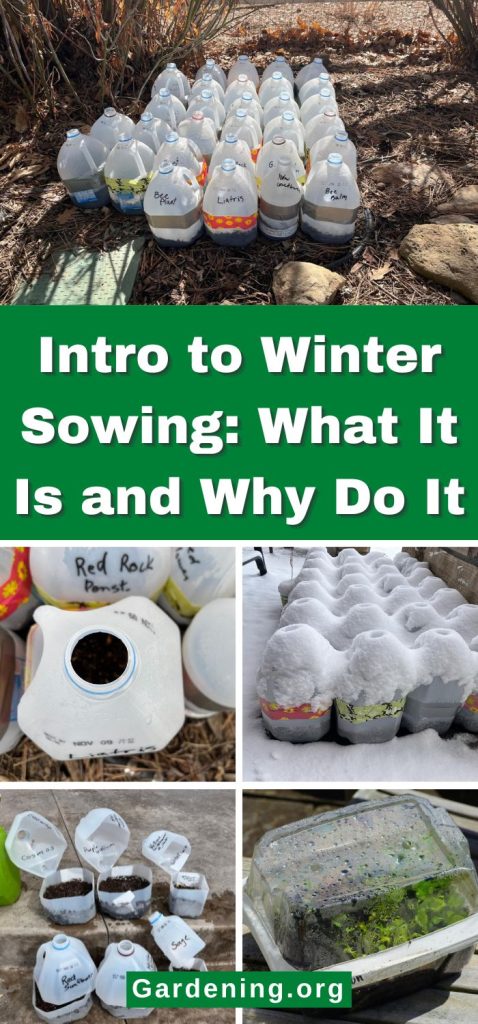

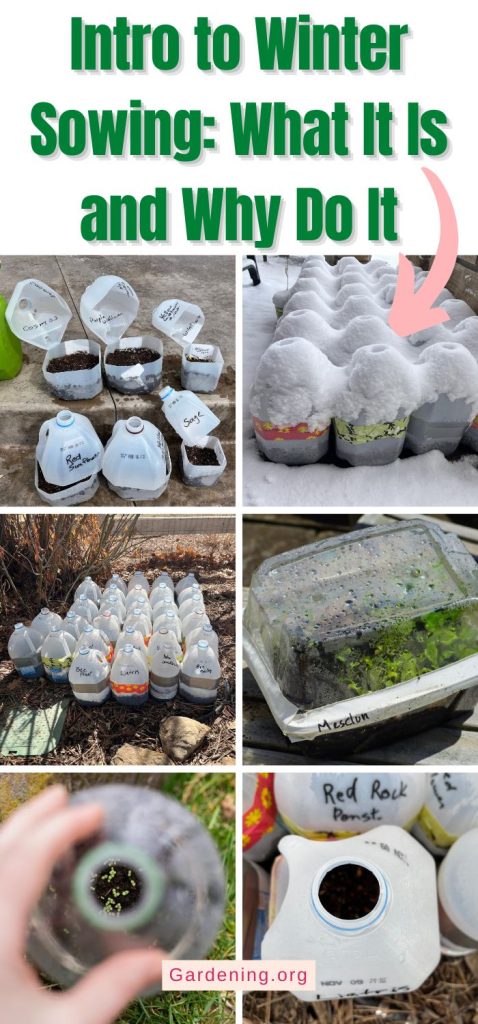
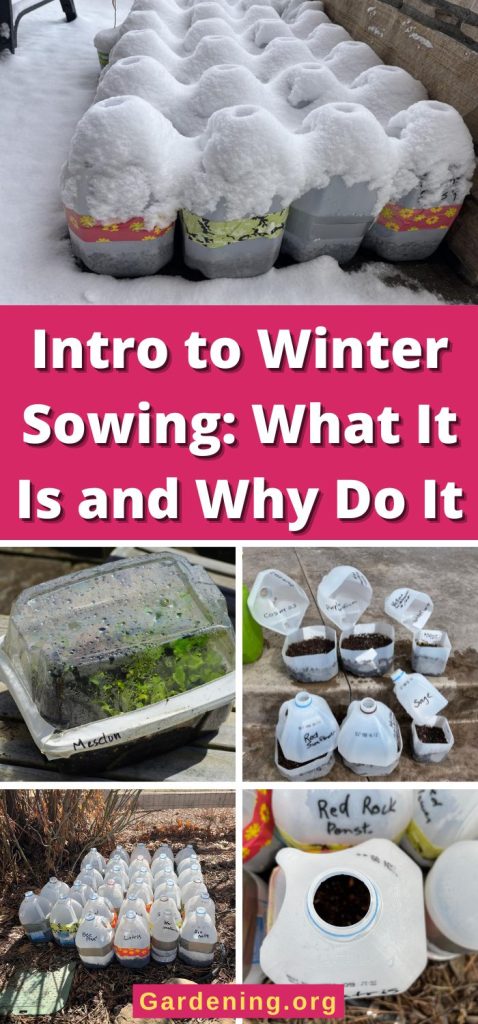

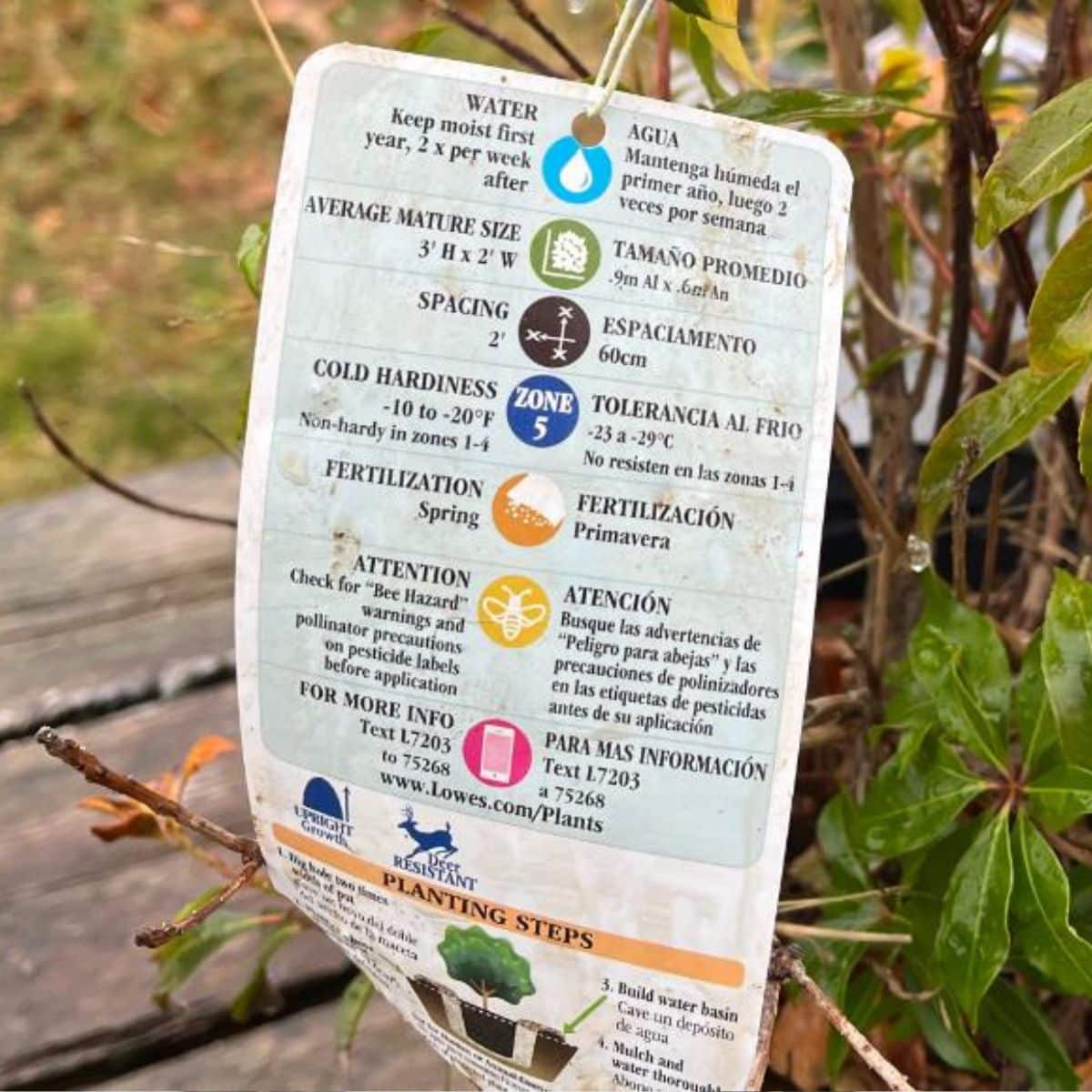
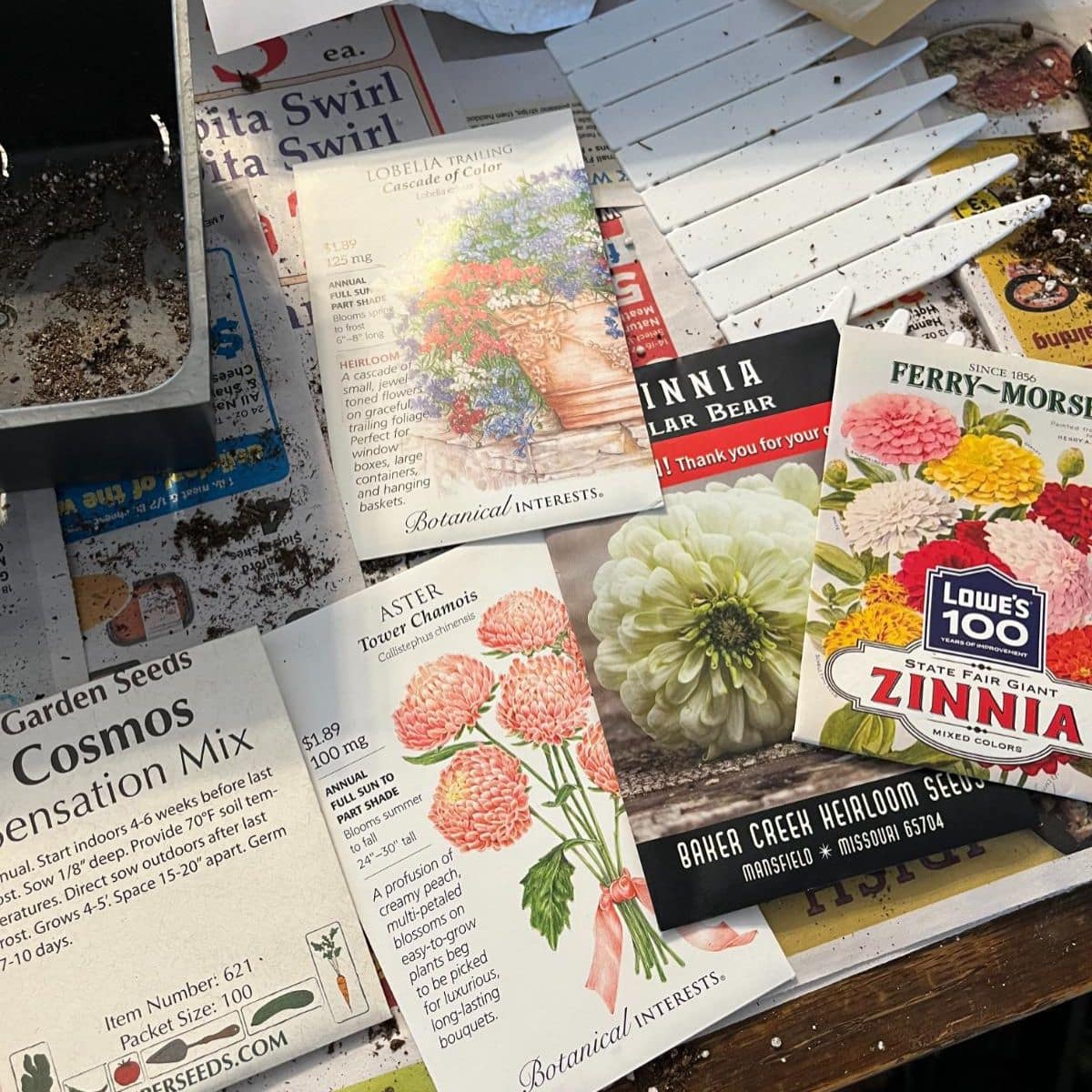
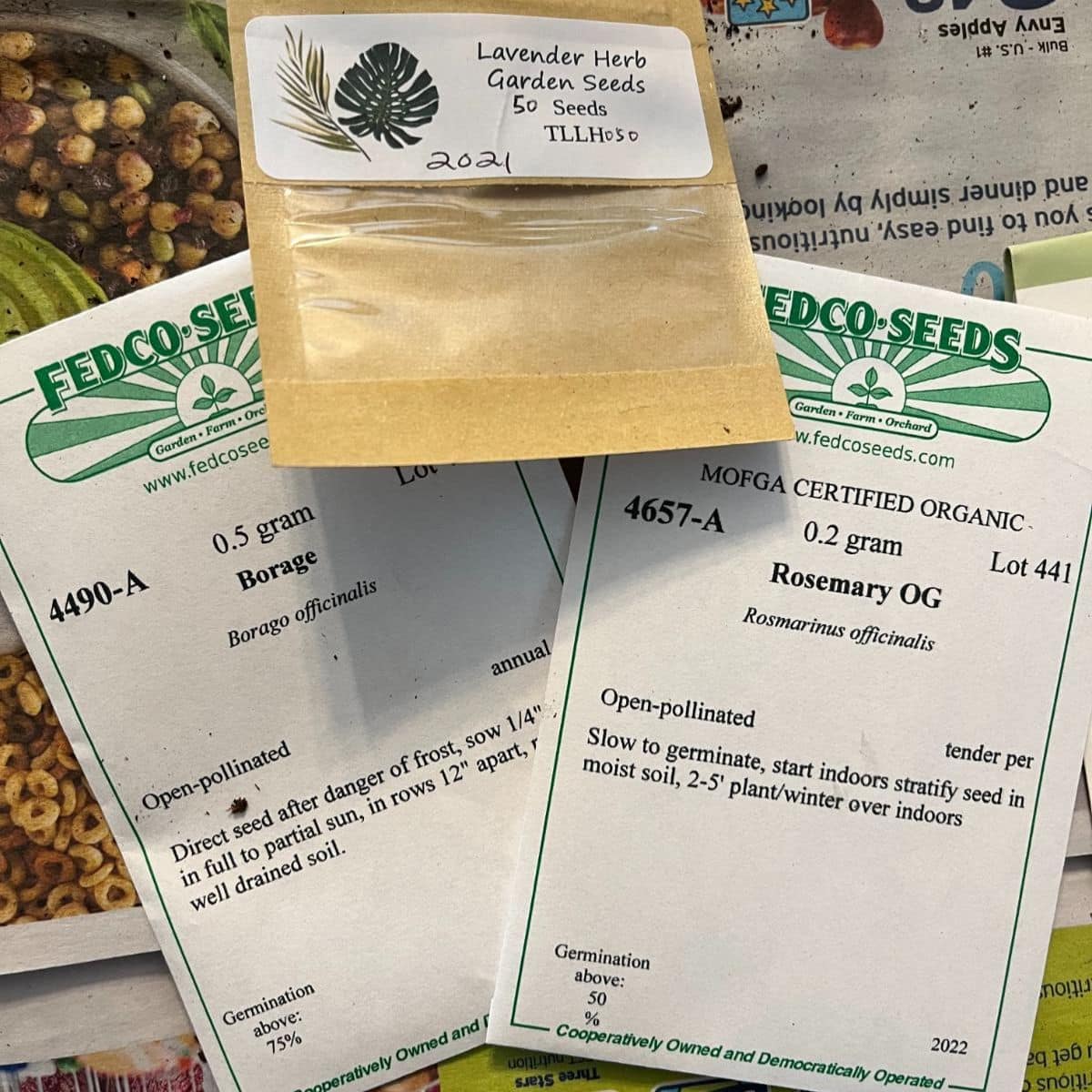
Sue Martin
So happy to find your post!!
I just “readied” my gallons jugs to put soil in but unfortunately it’s raining buckets where I live. Hopefully I’ll be able to get it all done soon!!
Mary Ward
Such crazy weather these days! I hope the clouds break!